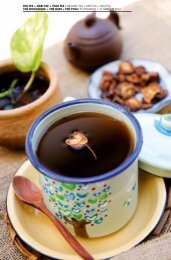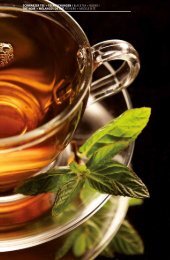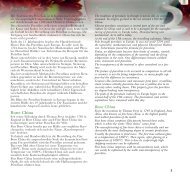Catalogo di té 2013_14 - Mount Everest Tea Company GmbH
Catalogo di té 2013_14 - Mount Everest Tea Company GmbH
Catalogo di té 2013_14 - Mount Everest Tea Company GmbH
You also want an ePaper? Increase the reach of your titles
YUMPU automatically turns print PDFs into web optimized ePapers that Google loves.
Schwarzer Tee + Teemischungen / black tea + Blends /Thé noir + Mélanges de thé / Tè nero + Miscele <strong>di</strong> tè• <strong>14</strong>.115 1,0 kg 2-5 Min. 12-15g/l 100°China Black Sencha -Bio-Diese Spezialität stammt aus der chinesischen Provinz Zhejiang.Der Herstellungsprozess gleicht einem klassischen grünen Sencha,nur mit dem Unterschied, dass <strong>di</strong>eser Tee fermentiert wird undso zu einem schwarzen Tee wird. Der Tee zeichnet sich aus durcheine feinherbe Röstnote, ist dabei jedoch ein milder bekömmlicherschwarzer Tee.*Chine Sencha, noir -Biologiques-Cette spécialité est issue de la province de Zhejiang. Le procédé defabrication est identique à celui d‘un thé vert classique Sencha, à laseule <strong>di</strong>fférence que ce thé est fermenté et devient un thé noir. Lethé se <strong>di</strong>stingue par sa note grillée d‘une fine amertume, mais estcependant un thé noir doux et <strong>di</strong>gestible.*china schwarz / china black / Chine Noir / Tè Nero dalla cinaChina Black Sencha -Organic-This speciality comes from the Chinese province of Zhejiang. Theproduction process is similar to a classic green Sencha with the only<strong>di</strong>fference being that this tea is fermented to become a black tea. Thetea is characterised by a finely tangy roasted touch, but remains amild and extremely pleasant black tea.*Sencha, Cina, nero -Biologice-Questa specialità è originaria della provincia <strong>di</strong> Zhejiang. Il processo<strong>di</strong> produzione è uguale a quello <strong>di</strong> un classico Sencha verde, con lasola <strong>di</strong>fferenza che questo tè viene fermentato <strong>di</strong>ventando quin<strong>di</strong> untè nero. Esso si <strong>di</strong>stingue anche per una nota tostata amarognolarestando comunque un tè nero <strong>di</strong>geribile e dal gusto morbido.*• <strong>14</strong>.155 1,0 kg 2-4 Min. 15-18g/l 100°China Yunnan FOPDer Tee stammt aus der gleichnamigen südchinesischen ProvinzYunnan, <strong>di</strong>e bekannt ist für seine weichen, milden Tees mit leichtrauchigem Geschmack. Mittelkräftiger Tee mit leicht er<strong>di</strong>grauchigerNote.Chine Yunnan FOPCe thé provient de la province du même nom du Yunnan en Chinedu sud, qui est connue pour ses thés souples et doux au goût légèrementfumé. Un thé moyennement corsé avec une note légèrementterreuse et fumée.China Yunnan FOPThis tea is grown in the southern chinese province Yunnan which isfamous for its mild teas with a little smoky taste.Cina Yunnan FOPIl tè proviene dall’omonima provincia dello Yunnan nella Cina meri<strong>di</strong>onale,conosciuta per i suoi tè morbi<strong>di</strong>, delicati, dal gusto che saleggermente <strong>di</strong> fumo. Tè me<strong>di</strong>amente forte dalla nota leggermenteterrosa e fumosa.• <strong>14</strong>.156 1,0 kg 2-4 Min. 15-18g/l 100°China Keemun CongouKeemun Tees werden in der chinesischen Provinz Anhui angebaut.Sie zeichnen sich aus durch eine runde, milde Tasse mit einem sehrgeringen Gerbsäureanteil. Ein regelmäßig gearbeitetes Blatt ergibteine Tasse mit dunkelrotem Abguss.Chine Keemun CongouLes thés Keemun sont cultivés dans la province chinoise d’Anhui.Ils se <strong>di</strong>stinguent par une tasse ronde et douce avec une proportiontrès faible d’acide tannique. Une feuille régulièrement travailléedonne une tasse ayant une infusion d’un rouge sombre.China Keemun CongouChina Keemun teas are produced in the province of Anhui, which isthe most important for tea in China. <strong>Tea</strong>s from Anhui are characterizedby their regular leaf with a small content of tannin acid. In thecup they show a nice dark red colour.Cina Keemun CongouI tè Keemun vengono coltivati nella provincia cinese <strong>di</strong> Anhui. Si <strong>di</strong>stinguonoper la loro infusione rotonda e delicata, con una quantitàminima <strong>di</strong> acido tannico. Il risultato della lavorazione regolare dellafoglia è un infuso dal colore rosso scuro.• <strong>14</strong>.300 1,0 kg 2-4 Min. 12 g/l 80-90°China Pu Erh TeePu Erh Tees wurden in der Vergangenheit für lange Jahre in derfeuchten Erde vergraben, wodurch sie ihren einzigartigen kräftigen,er<strong>di</strong>gwürzigen Geschmack und Geruch erhielten. Heutzutage werdenPu Erh Tees nach der Fermentation erneut befeuchtet und indunklen Gemäuern gelagert. Der nachfermentierte Tee aus der ProvinzYunnan ergibt eine dunkelrote Tasse.Chine Pu Erh ThéLes thés Pe Erh ont été dans le passé enterrés dans la terre humidependant de nombreuses années, ce qui leur a donné leur goûtcorsé unique épicé et terreux et leur odeur. Aujourd’hui, les thésPe Erh sont réhumi<strong>di</strong>fiés après leur fermentation et stockés dansdes pièces sombres. Ce thé refermenté provenant de la province deYunnan donne une tasse rouge sombre.china spezialitäten / china specialities / Chine Spécialités / Specialità dalla cinaChina Pu Erh <strong>Tea</strong>In the past the Pu Erh teas were buried in the ground where they gottheir unique tangy earthy taste. Nowadays the teas are moisturizedafter the fermentation again and are stored in wide dark cellars formore than one year. The perfermented tea has a red cup.Cina Pu Erh TèIn passato i tè Pu Erh venivano conservati per anni sotto la terra umida,ottenendo così la loro fragranza unica e il gusto forte e terroso.Oggi i tè Pu Erh, dopo la fermentazione, vengono inumi<strong>di</strong>ti <strong>di</strong> nuovoe conservati in cantine buie. Il tè post-fermentato dalla provincia delloYunnan dà un in - fuso rosso scuro con un gusto intenso e terroso.17








